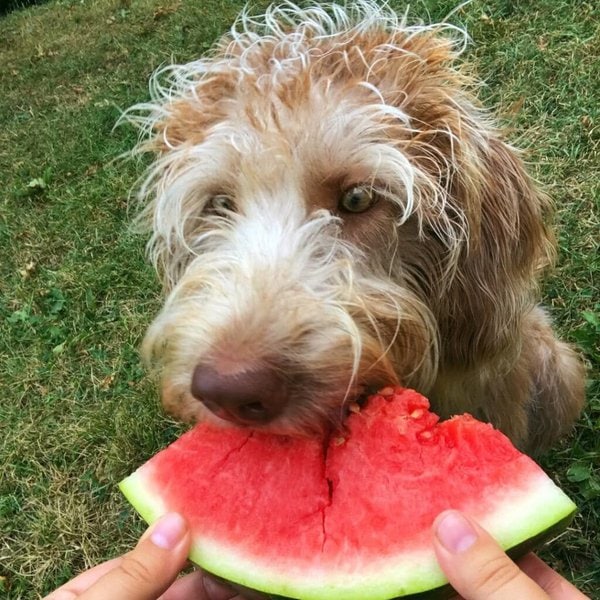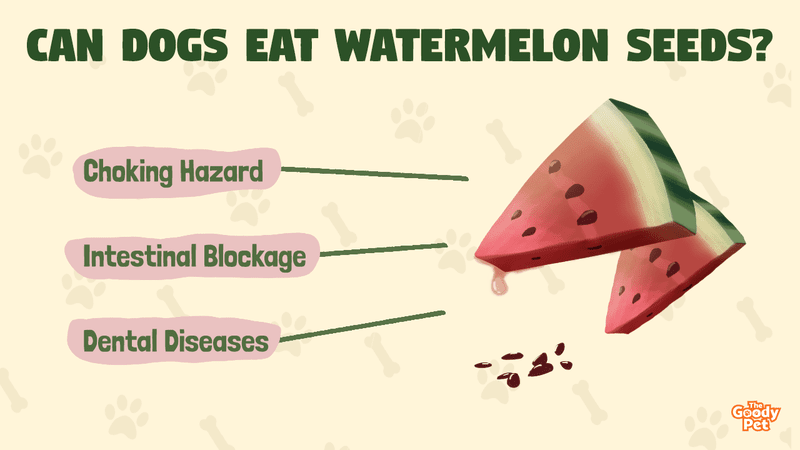The ideal way to eat watermelon is to munch the juicy fruit and spit out the seeds, mainly because they don’t taste palatable. Some folks still eat watermelon seeds to enjoy the nutritional benefits, though not all suffer harm. For dogs, can they, too, consume watermelon seeds to enjoy the same health benefits?
No, dogs cannot eat watermelon seeds because canines’ digestive tracts are not designed to handle edible substances with a tough, indigestible exterior. Also, when dogs consume watermelon seeds, they sometimes have gastrointestinal blockages—a dangerous phenomenon that could terminate a dog’s life.
In this article, you’ll learn why watermelon seeds are dangerous to dogs, how to effectively remove seeds from watermelon, what to do when a dog swallows watermelon seeds, whether dogs can eat immature watermelon seeds, and if watermelon seeds contain cyanide.
Why Are Watermelon Seeds Dangerous To Dogs?
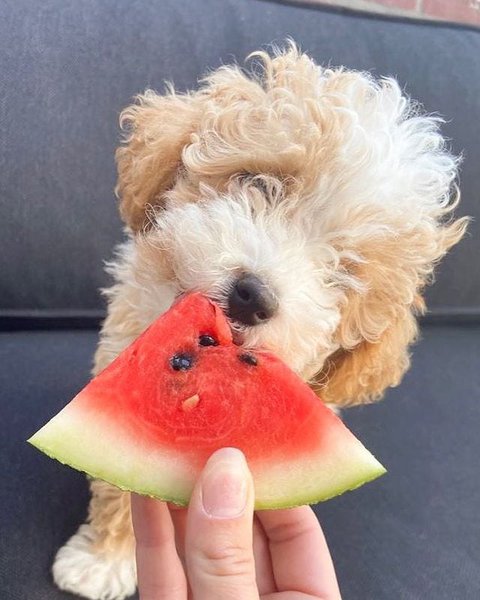
Dogs can’t eat watermelon seeds because of certain factors. Listed below are three main reasons you shouldn’t feed your canine seeds with a rugged exterior:
Choking Hazard
Your furry pal could suffer from a choking hazard after eating a slice of watermelon if it tends to sniff its meals before eating. Hence, a sniffing dog could draw up one or two seeds that may get stuck in the nasal cavity.
And, since the nasal cavity is the pathway where air passes through the lungs, obstruction by a couple of watermelon seeds can block off the oxygen supply to the lungs, ultimately leading to choking and unconsciousness.
In addition, asides from the dangers of a choking hazard, the physical discomfort of having their nostrils blocked by watermelon seeds partially can cause dogs to become restless.
Signs of a choking hazard in dogs include frequent wheezing, paleness, incoordination, etc.
Intestinal Blockage
Intestinal blockage occurs when a dog’s digestive system cannot break down swallowed substances because they’re too large or tough for the stomach to digest.
When these indigestible substances remain in the stomach without catabolism, they move into the narrower vacuum of the intestine, blocking the passage and absorption of digested food.
Watermelon seeds aren’t easily digestible because they have a somewhat tough exterior. Consequently, when the seeds enter the stomach, they accumulate, eventually blocking the intestines.
When intestinal blockage sets in, the first sure sign to notice is repeated vomiting and abdominal pains. Other symptoms may include bloating, loss of appetite, dehydration, etc.
The solution to intestinal blockage in dogs is almost always surgery. And the sooner surgery occurs, the lower the fatality rate of gastrointestinal obstruction in dogs becomes.
Dental Diseases
Whole or fragmented pieces of watermelon seeds can get lodged in your pooch’s teeth and start to cause the build-up of bacteria. When accumulated in sufficient quantities, bacteria can cause gums to swell, causing plaque and tooth decay which introduce massive discomfort in your canine pal.
Can My Dog Eat Raw Watermelon Seeds?
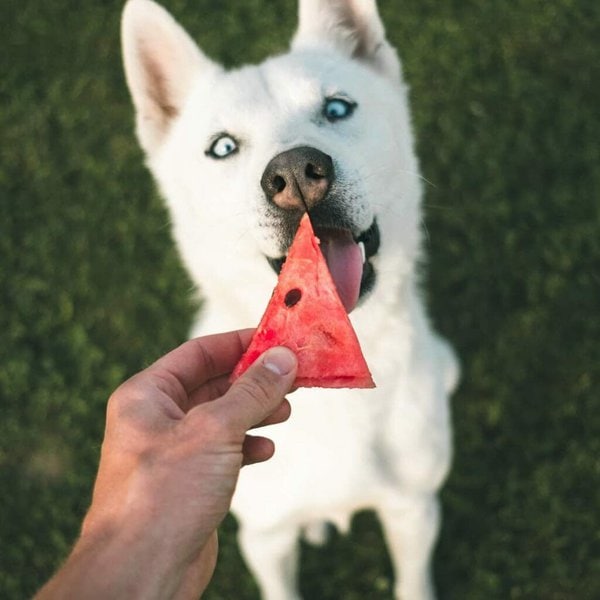
Yes, dogs can eat raw watermelon seeds. Certain watermelons have raw seeds that appear white, tiny, and easily digestible because the fruit is not yet mature.
After consumption, such raw seeds should not pose a health threat to your canine pal, so there’s no need to worry about a choking hazard.
However, keep in mind that watermelons with raw seeds don’t always turn out sweet and may not be appealing to your pooch.
Do Watermelon Seeds Contain Cyanide?
No, watermelon seeds don’t contain cyanide and ordinarily wouldn’t be harmful to dogs if not for the dangers of a choking hazard.
In fact, watermelon seeds are a rich source of vitamins, proteins, and fatty acids and would otherwise have been a great source of nutrition for your furry buddy.
What To Do If My Dog Eats Watermelon Seeds?
If your furry pal eats a slice of watermelon lying around, then there shouldn’t be a problem. But say your pooch ate half of a watermelon fruit or more, there could be a cause for alarm.
Once you detect that your canine has eaten a forbidden-many-seeded fruit like watermelon, you’ll need to contact the vet immediately.
Keep in mind that some large dog breeds like the Rottweiler and German Shepherd might not manifest any symptoms because their digestive systems are equipped enough to deal with small foreign elements like seeds.
Nonetheless, the symptom of intestinal blockage may not arise until much later, when you might not be present to deliver speedy assistance. So, in this case, the adage “it’s better to be safe than sorry” rings true.
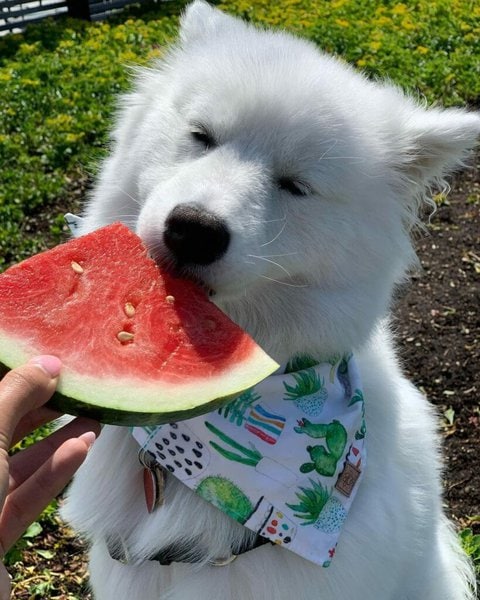
What To Do If My Dog Sniffs Up A Watermelon Seed While Eating?
When your furry buddy has a wholly or partially blocked nostril because of sniffing up watermelon seeds, the right thing to do next is to seek medical help fast, especially if both nostrils are blocked, causing asphyxiation.
Now, before the vet or ambulance arrives, you can try to save your dear Fido’s life by extracting the object of obstruction if possible.
Start by grabbing a pair of tweezers. Next, calm your pooch if it’s not unconscious already, and get it to remain still.
Once your canine is still, tilt its head backward and try to peer down its nostril to view the seed. Also, it might help if you use a flashlight to illuminate the dark nasal cavity.
If the seed is visible, use the pair of tweezers to extract the seed, taking care to do so slowly.
Also, endeavor to be careful not to knock the seed farther back as the nasal cavity only becomes narrower further down the throat.
If you think the seed is lodged way farther than you can reach, the ultimate solution will be to wait for the vet.
Therefore, to avoid these unnecessary risks, we will look at an easier way to deal with watermelon seeds.
How Do I De-Seed A Watermelon Fruit For My Dog?
To the ordinary eye, the seeds in a watermelon fruit appear haphazardly. But experienced chefs know that watermelon seeds exist in arranged patterns and cut the fruit using a method that makes the seeds easily removable.
So here’s how to de-seed a watermelon:
- Wash the watermelon fruit and cut off both ends with a knife.
- With both ends of the watermelon gone, you should be able to place the fruit upright to begin cutting off the green rind. Once started, keep rotating the fruit until the entire green is gone, exposing a standing, thick block of red fleshy fruit on the cutting board.
- Lay the upright watermelon flat on the board and cut it vertically in two halves so they each take the shape of a ceramic bowl.
- Take one of the halves and face the flat side downwards to look like an upturned ceramic bowl, then cut the fruit with a couple of vertical strokes so it comes out in multiple slices.
- Take one of the slices, and you should see the watermelon seeds arranged in two vertically opposite lines.
- Break the slice of watermelon along one of those lines, and with a knife or spoon, remove the seeds from the fruit’s flesh.
